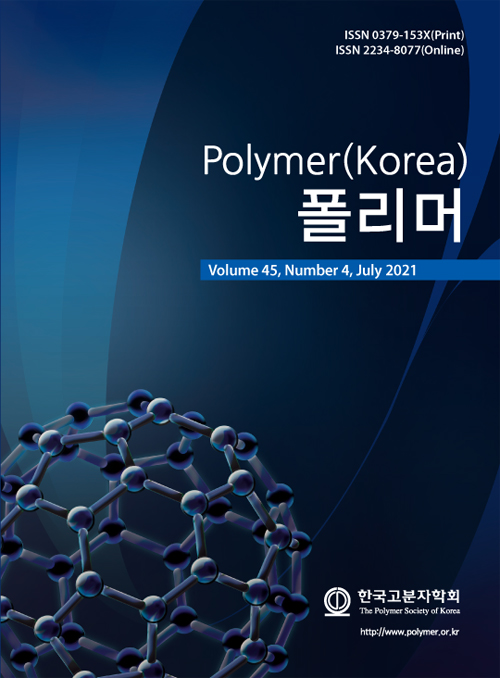- Development of Sprayable Gelatin Hydrogel Wound Dressings Using Enzymatic Crosslinking Reaction
Gwijae Kim, Young-Gwang Ko, Hyeyoung Lee, Ho Yun Chung*, and Oh Hyeong Kwon†

Department of Polymer Science and Engineering, Kumoh National Institute of Technology, Gumi, Gyeongbuk 39177, Korea
*Department of Plastic and Reconstructive Surgery, CMRI, School of Medicine, Kyungpook National University, Daegu 41944, Korea- 효소촉매 가교반응을 이용한 스프레이형 젤라틴 하이드로젤 창상피복제의 개발
금오공과대학교 고분자공학과, *경북대학교 의과대학 성형외과, 세포기질연구소
Reproduction, stored in a retrieval system, or transmitted in any form of any part of this publication is permitted only by written permission from the Polymer Society of Korea.
References
- 1. Langer, R.; Vacanti, J. P. Tissue Engineering. Science 1993, 260, 920-926.
-

- 2. Hollister, S. J. Porous Scaffold Design for Tissue Engineering. Nat. Mater. 2006, 4, 518-524.
-

- 3. Hubbell, J. A. Biomaterials in Tissue Engineering. Nat. Biotechnol.1995, 13, 565-576.
-

- 4. Hanna, J. R.; Giacopelli, J. A. A Review of Wound Healing and Wound Dressing Products. J. Foot Ankle Surg. 1997, 36, 2-14.
-

- 5. Zeng, D.; Shen, S.; Fan, D. Molecular Design, Synthesis Strategies and Recent Advances of Hydrogels for Wound Dressing Appli- cations. Chin. J. Chem. Eng. 2021, 30, 308-320.
-

- 6. Zhang, M.; Zhao, X. Alginate Hydrogel Dressings for Advanced Wound Management. Int. J. Biol. Macromol. 2020, 162, 1414-1428.
-

- 7. Ngece, K.; Aderibigbe, B. A.; Ndinteh, D. T.; Fonkui, Y. T.; Kumar, P. Alginate-Gum Acacia Based Sponges as Potential Wound Dressings for Exuding and Bleeding Wounds. Int. J. Biol. Macromol. 2021, 172, 350-359.
-

- 8. Winter, G. D. Formation of the Scab and the Rate of Epithe- lization of Superficial Wounds in the Skin of the Young Domestic Pig. Nature 1962, 193, 293-294.
-

- 9. Cheng, H.; Shi, Z.; Yue, K.; Huang, X.; Xu, Y.; Gao, C.; Yao, Z.; Zhang, Y. S.; Wang, J. Sprayable Hydrogel Dressing Accelerates Wound Healing with Combined Reactive Oxygen Species-Scavenging and Antibacterial Abilities. Acta Biomater. 2021, 124, 219-232.
-

- 10. Amirsadeghi, A.; Jafari, A.; Hashemi, S.-S.; Kazemi, A.; Ghasemi, Y.; Derakhshanfar, A.; Shahbazi, M.-A.; Niknezhad, S. V. Sprayable Antibacterial Persian Gum-Silver Nanoparticle Dressing for Wound Healing Acceleration. Mater. Today Commun. 2021, 27, 102225.
-

- 11. Dauton, C.; Kothari, S.; Smith, L.; Steele, D. A. History of Materials and Practices for Wound Management, Wound Practice and Research 2012, 20, 174-186.
-

- 12. Varaprasad, K.; Raghavendra, G. M.; Jayaramudu, T. A Mini Review on Hydrogels Classification and Recent Developments in Miscellaneous Applications. Mater. Sci. Eng. C 2017, 79, 958-971.
-

- 13. Ullah, F.; Othman M. B. H.; Javed, F.; Ahmad, Z.; Akil, H. M. Classification, Processing and Application of Hydrogels: A Review. Mater. Sci. Eng. C 2015, 57, 414-433.
-

- 14. Bang, S.; Lee, E.; Ko, Y.-G.; Kim, W. I.; Kwon, O. H. Injectable Pullulan Hydrogel for the Prevention of Postoperative Tissue Adhesion. Int. J. Biol. Macromol. 2016, 87, 155-162.
-

- 15. Lee, F.; Chung, J. E.; Kurisawa, M. An Injectable Enzymatically Crosslinked Hyaluronic Acid-Tyramine Hydrogel System with Independent Tuning of Mechanical Strength and Gelation Rate. Soft Matter 2008, 4, 880-887.
-

- 16. Bang, S.; Ko, Y.-G.; Kim, W. I.; Cho, D.; Park, W. H.; Kwon, O. H. Preventing Postoperative Tissue Adhesion Using Injectable Carboxymethyl Cellulose-Pullulan Hydrogels. Int. J. Biol. Macromol. 2017, 105, 886-893.
-

- 17. Martinez-Diaz, G. J.; Nelson, D.; Crone, W. J.; Kao, W. J. Mechanical and Chemical Analysis of Gelatin-Based Hydrogel Degradation. Macromol. Chem. Phys. 2003, 204, 1898-1908.
-

- 18. Kim, Y.-H.; Cho, C.-S.; Kang, I.-K.; Kim, S. Y.; Kwon, O. H. Crosslinked Gelatin Nanofibers and Their Potential for Tissue Engineering. Key Eng. Mater. 2007, 342, 169-172.
-

- 19. Zhao, X.; Lang, Q.; Yildirimer, L.; Lin, Z. Y.; Cui, W.; Annabi, N.; Ng, K. W.; Dokmeci, M. R.; Ghaemmaghami, A. M.; Khademhosseini, A. Photocrosslinkable Gelatin Hydrogel for Epidermal Tissue Engineering. Adv. Healthc. Mater. 2016, 5, 108-118.
-

- 20. Sakai, S.; Hirose, K.; Taguchi, K.; Qgushi, Y.; Kawakami, K. An Injectable, In Situ Enzymatically Gellable, Gelatin Derivative for Drug Delivery and Tissue Engineering. Biomaterials 2009, 30, 3371-3377.
-

- 21. Akkara, J. A.; Senecal, K. J.; Kaplan, D. L. Synthesis and Characterization of Polymers Produced by Horseradish Peroxidase in Dioxane. J. Polym. Sci.: A Polym. Chem. 1991, 29, 1561-1574.
-

- 22. Ghasempur, S.; Torabi, S. F.; Siadat, S. O. R.; Heravi, M. J.; Ghami, N.; Khajeh, K. Optimization of Peroxidase-Catalyzed Oxidative Coupling Process for Phenol Removal from Wastewater Using Response Surface Methodology. Environ. Sci. Technol. 2007, 41, 7073-7079.
-

- 23. Linh, N. T. B.; Abueva, C. D. G.; Lee, B.-T. Enzymatic In Situ Formed Hydrogel from Gelatin–Tyramine and Chitosan-4-Hydr- oxylphenyl Acetamide for the Co-Delivery of Human Adipose-Derived Stem Cells and Platelet-Derived Growth Factor Towards Vascularization. Biomed. Mater. 2017, 12, 015026.
-

- 24. Kiselioviene, S.; Baniukaitiene, O.; Harkavenko, V.; Babenko, N. A.; Liesiene, J. Cellulose Hydrogel Sheets for Wound Dressings. Cellulose Chem. Technol. 2016, 50, 915-923.
- Polymer(Korea) 폴리머
- Frequency : Bimonthly(odd)
ISSN 0379-153X(Print)
ISSN 2234-8077(Online)
Abbr. Polym. Korea - 2023 Impact Factor : 0.4
- Indexed in SCIE
 This Article
This Article
-
2021; 45(4): 610-619
Published online Jul 25, 2021
- 10.7317/pk.2021.45.4.610
- Received on Mar 28, 2021
- Revised on Apr 21, 2021
- Accepted on Apr 29, 2021
 Correspondence to
Correspondence to
- Oh Hyeong Kwon
-
Department of Polymer Science and Engineering, Kumoh National Institute of Technology, Gumi, Gyeongbuk 39177, Korea
- E-mail: ohkwon@kumoh.ac.kr









 Copyright(c) The Polymer Society of Korea. All right reserved.
Copyright(c) The Polymer Society of Korea. All right reserved.